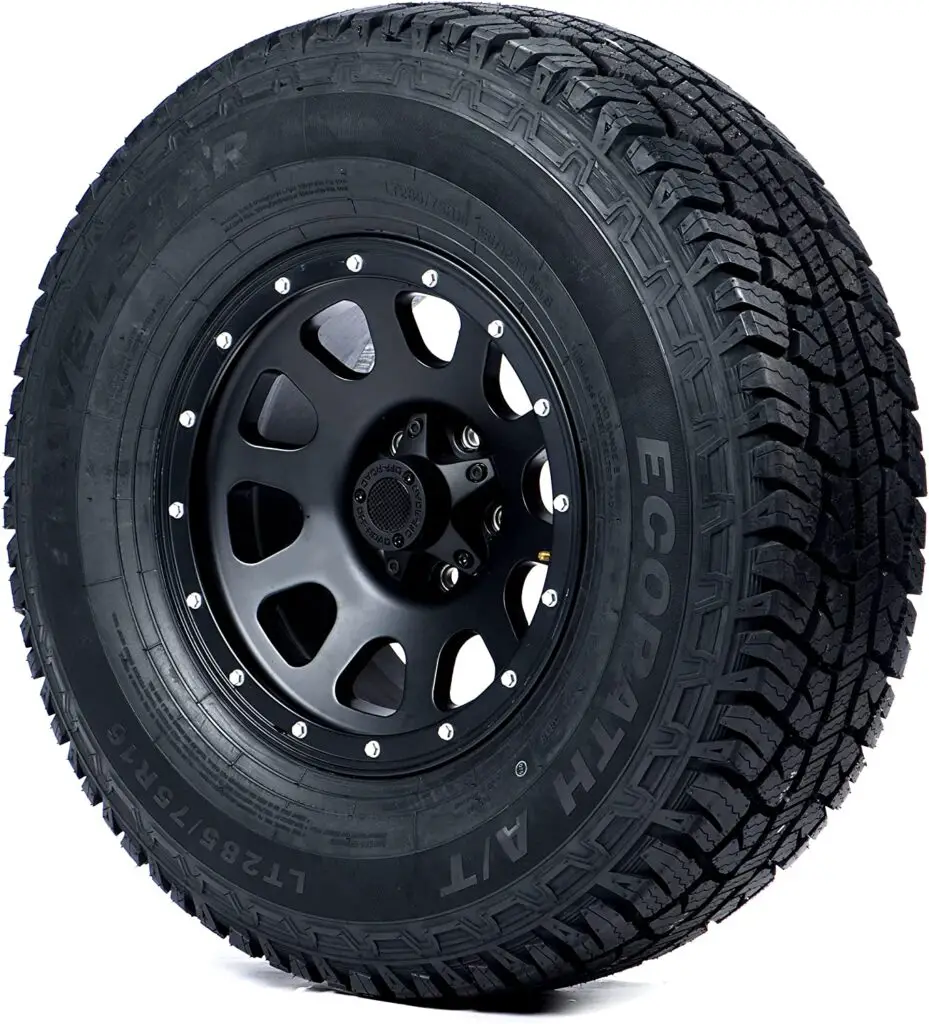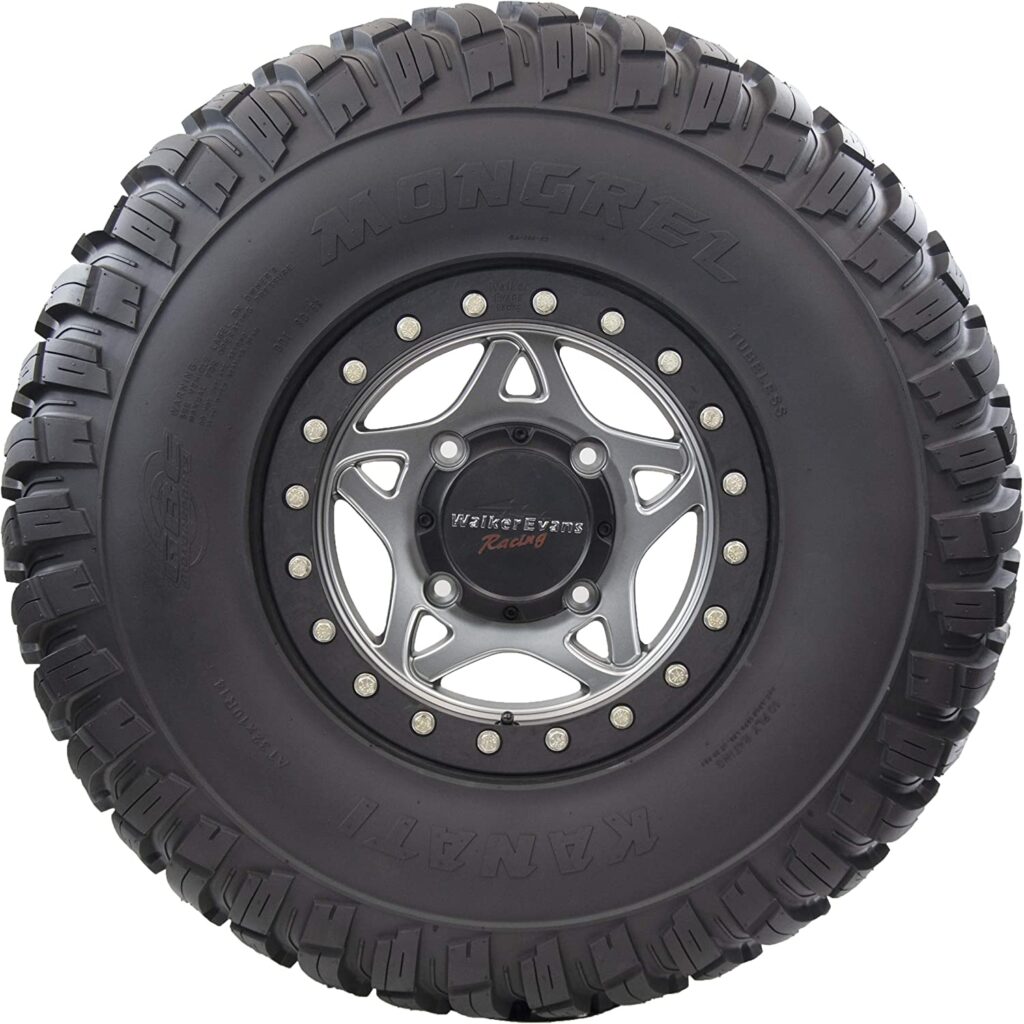A 6-ply tire has six layers of material, usually a combination of rubber and fabric or steel, reinforcing the tire’s structure and providing stability.
Tires of this type are better suited to cars more concerned with fuel efficiency and ride comfort than towing capacity or off-road capability, as they are lighter and more flexible.
On the other hand, a 10-ply tire is constructed with ten layers of material. That makes it more robust and capable of withstanding higher loads and rougher terrain.
But these tires are stiffer and less flexible due to the additional layers of material. Which can lead to a rougher ride and decreased fuel efficiency.
What’s Tire Ply Rating?
Here is a table about tire ply rating and maximum load pressure based on the download range.
| Load Range | Ply Rating | Maximum Load Pressure |
|---|---|---|
| B | 4 | 35 psi |
| C | 6 | 50 psi |
| D | 8 | 65 psi |
| E | 10 | 80 psi |
| F | 12 | 95 psi |
Ply rating measures a tire’s strength and load-carrying capabilities. It describes how many layers or plies of material were utilized to make the tire’s casing.
In the past, a tire’s “ply rating” indicated the number of layers of rubber or fabric used in its construction. The ply rating no longer reflects the number of layers because modern tires use steel belts and other composite materials.
Instead, tires now have codes that show their load capacities based on their ply ratings. For greater load-bearing capacity, a higher ply rating is preferable. Tires with higher ply ratings, such as 8, are constructed to support more weight than tires with lower ratings, such as 6.
As the ply rating system does not accurately depict a tire’s durability, it is no longer officially used. Nowadays, the phrase “load range” is used.
The tire’s load range is denoted by a three-letter code (C, D, or E) that specifies the greatest load the tire can support at a specific air pressure.
Ply rating is just one factor determining a tire’s load-carrying capacity, and other factors such as the tire’s size, construction, and intended use.
About 6-Ply Tires

Tires of 6-ply construction are common on automobiles, SUVs, and light trucks. Compared to tires with more plies, these are often lighter, leading to greater fuel efficiency and lower operating expenses. The enhanced riding comfort of 6 ply tires is another benefit.
There are fewer layers of material, so they are often softer and more flexible, making for a more comfortable and noise-free ride. Long-distance drivers and those sensitivities to noise and vibrations may benefit the most from this.
Where to Use 6-Ply Tires?
Here are some fields where we usually use 6-ply tires. Such as-
- Off-roading: 6-ply tires can offer the grip and durability needed to tackle rocky terrain if you love driving on it or often take your car off-road.
- Agriculture: Agricultural machinery tires must be built to last if they are to be used on the road. Tires of 6-ply construction are recommended due to the rugged terrain and heavy loads.
- Heavy-duty pickup trucks: 6-ply tires can give the essential load-carrying capability and durability if you routinely haul big cargo or use your pickup truck for business.
Drawbacks of 6 Ply Tires
Tires with 6 plies may not hold well on rocky roads or high loads. Compared to tires with more plies, they are more likely to be damaged and worn under difficult driving circumstances due to their reduced load-carrying ability and poorer puncture resistance.
About 10-Ply Tires

Due to their strength and durability, 10-ply tires are among the best options for heavy-duty applications. Trucks, SUVs, and other heavy-duty vehicles typically use ten-ply tires because of their extra support when hauling high loads or working in harsh circumstances.
Moreover, they are much harder to puncture than conventional tires. Furthermore, the sidewalls of 10-ply tires are more robustly protected. That allows them to withstand more stress in typical urban conditions, such as while driving over severe potholes or colliding with curbs.
Where To Use 10-Ply Tires?
Here are some fields where we usually use 6-ply tires. Such as-
- Heavy-duty trucks: Heavy-duty vehicles used for transporting and towing huge cargo often have tires with 10-ply construction. They are perfect for long journeys and rough weather because of their increased durability.
- Commercial vehicles: Tires with 10 plies are often better suited to commercial vehicles with high use and load capacities, like delivery vans, box trucks, and other fleet vehicles.
- Trailers: Trailers that transport heavy machinery, building supplies, or other bulky loads may benefit from the extra strength and stability of 10-ply tires.
- RVs and campers: RVs and campers often utilize 10-ply tires due to their increased load capacity and durability.
Drawbacks of 10 Ply Tires
Extra-sturdy tires are unnecessary if you don’t pull or transport frequently. Instead of spending money on new parts, you should put that money into regular maintenance like oil changes and tune-ups. Which will keep your automobile running at its best.
Those driving trucks or cars used to transport large equipment and machinery are the only ones who should be using them.
6-Ply Vs. 10-Ply Tires: Main Differences
The following are the primary distinctions between 6-ply and 10-ply tires:
Performance
Compared to 6-ply tires, 10 ply tires provide superior handling and stability. As a result of the additional layers, the tire is less likely to distort when subjected to high speeds or large loads.
Moreover, 10-ply tires are more resistant to heat buildup and form retention, resulting in a more stable and comfortable ride. While some people may prefer the added rigidity that a 10-ply tire provides, others may find the extra layers unnecessary.
Durability
When compared to 6-ply tires, 10-ply tires are often recognized as being the more durable option. A 10-ply tire has superior puncture resistance due to its several layers of reinforcement.
Due to the several layers, the tire is less likely to flip over on abrupt curves or uneven ground. Thus, off-road or heavy-duty cars driving over rugged terrain or through other risks often opt for 10-ply tires.
Price
10-ply tires are often more expensive than 6-ply tires because of the additional materials and reinforcements utilized in their production.
While 10-ply tire costs more, its advantages in terms of longevity and performance can convince some buyers to make the purchase.
Load Capacity
When choosing between 10-ply and 6-ply tires, the tire’s load capacity is essential. 10-ply tires are preferable to six-ply tires for carrying high loads because of their increased capacity.
In addition, a 10-ply tire’s additional layers provide stability and support, decreasing the likelihood of tire failure or blowouts.
Air Pressure Capacity
Tires with a 6-ply rating can sustain air pressure of up to 50 psi (350 kPa). Nevertheless, a 10-ply tire, which can sustain up to 80PSI (kPa) of air pressure. It can carry greater weight than a 6-ply tire without compromising its structural integrity while fully inflated.
Tread Life
A tire’s tread life is the number of miles it can travel before it becomes too worn to continue using it safely. Due to the increased durability and resistance to wear that the additional layers of a 10-ply tire give, they tend to last longer than their 6-ply counterparts.
It is important to remember that tire pressure, driving habits, and road conditions can all affect tread life.
6 Ply Vs. 10 Ply Tires: Which One Better for You?
Consider the vehicle type, the planned use, and the road conditions before settling on 6-ply or 10-ply tires. Ply describes the internal structure of a tire, which is constructed from many layers of material (often fabric or steel).
A tire’s strength and longevity increase proportionally with the number of plies it has. A 10-ply tire may be the best choice for a large vehicle or SUV that often transports heavy loads, such as building supplies or equipment.
The 10-ply tire can withstand the additional pressure and weight of large loads due to its superior strength and longevity.
Also, a 10-ply tire might give superior protection against punctures and rips compared to a 6-ply tire if you often travel unpaved or rough roads.
In contrast, a 6-ply tire will be enough if you operate a smaller vehicle (such as a car or light truck) and rarely transport big loads or travel over rugged terrain.
However, it is essential to consider how you’ll be using the car and the terrain it will be driven on before deciding between 6-ply and 10-ply tires.
Lastly, 10-ply tires will be the best choice if you frequently deal with large loads or tough terrain. Again, a 6-ply tire will be more appropriate if you value ride comfort and fuel efficiency more than heavy-duty performance.
